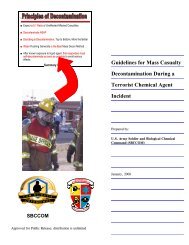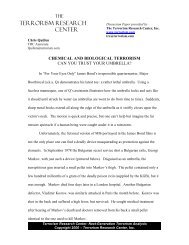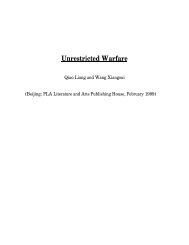Combating Proliferation of Weapons of Mass Destruction
Combating Proliferation of Weapons of Mass Destruction
Combating Proliferation of Weapons of Mass Destruction
You also want an ePaper? Increase the reach of your titles
YUMPU automatically turns print PDFs into web optimized ePapers that Google loves.
While there has been considerable progress in U.S. intelligence capability, much remainsto be done to meet policy needs. There are no better reminders <strong>of</strong> the need forimprovement than the unexpected Indian nuclear test in May 1998 and North Korea’s test<strong>of</strong> a three-stage ballistic missile in August 1998. Similarly, the importance <strong>of</strong> intelligencefor warning about potential terrorist use <strong>of</strong> weapons <strong>of</strong> mass destruction was reinforced bythe revelation that environmental samples and other intelligence indicated that Usama BinLadin’s terrorist organization was interested in acquiring chemical weapons and had linksto the presence <strong>of</strong> a VX nerve agent precursor in Sudan. And surely our leaders deservea detailed appraisal <strong>of</strong> how well Russia is controlling its nuclear stockpile, its inventory <strong>of</strong>strategic nuclear and other WMD-related materials, its technology, and the technicalpersonnel who work, or have worked, on its nuclear, chemical, and biological weapons.Our objectives for proliferation-related intelligence should include the following:• The earliest possible warning <strong>of</strong> imminent and emerging WMD threats, including use,significant testing milestones, and technological surprises;• Accurate information and assessments about the WMD programs and operationalpractices <strong>of</strong> nations and sub-national groups, including associated delivery systemsand related technology, along with identification <strong>of</strong> vulnerabilities;• Greater understanding <strong>of</strong> the particular strategic, regional, and internal factors thatmotivate a country or sub-national group to acquire, or use, WMD capabilities, as wellas key points <strong>of</strong> leverage for influencing such decisions;• Identification <strong>of</strong> critical links and nodes in the web <strong>of</strong> selling, buying, and brokeringWMD technology and materials, as well as vulnerabilities in those procurementnetworks; and• Resource allocation in the IC should reflect the high priority accorded to combatingproliferation.Considerable collection and analytic resources are required to accomplish theseobjectives. Both collection and analysis must be better planned, managed, and organized,along both functional lines that stress the weapons and their means <strong>of</strong> delivery and alongregional lines, so that the political and security contexts that lead to demand for theseweapons are better understood.It is also important to address the relationship between intelligence and its customers, inboth Congress and the executive branch, and the ways in which this relationship can affectthe quality <strong>of</strong> the intelligence. Good intelligence is fundamental to combating proliferation.Most efforts to acquire weapons <strong>of</strong> mass destruction are shrouded in secrecy, deception,and denial; the Intelligence Community must pierce that shroud. In only the rarest cases—as in Iraq immediately after the Gulf War—can we quickly uncover vast quantities <strong>of</strong>67







